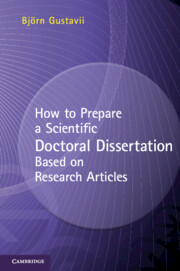Book contents
- Frontmatter
- Contents
- Preface
- Acknowledgments
- 1 Introduction
- 2 Compilation – the article-based thesis
- 3 Front cover illustration
- 4 Title
- 5 Abstract
- 6 Quotations
- 7 Thesis at a glance
- 8 Abbreviations
- 9 List of publications
- 10 Contributors
- 11 Popularized summary
- 12 Acknowledgments
- 13 General introduction
- 14 Aims
- 15 Methods
- 16 Results
- 17 General discussion
- 18 Copyright
- 19 A dissertation worth considering
- Appendix A To the authorities at the graduate division
- Literature cited
- Index
13 - General introduction
Published online by Cambridge University Press: 05 November 2012
- Frontmatter
- Contents
- Preface
- Acknowledgments
- 1 Introduction
- 2 Compilation – the article-based thesis
- 3 Front cover illustration
- 4 Title
- 5 Abstract
- 6 Quotations
- 7 Thesis at a glance
- 8 Abbreviations
- 9 List of publications
- 10 Contributors
- 11 Popularized summary
- 12 Acknowledgments
- 13 General introduction
- 14 Aims
- 15 Methods
- 16 Results
- 17 General discussion
- 18 Copyright
- 19 A dissertation worth considering
- Appendix A To the authorities at the graduate division
- Literature cited
- Index
Summary
Also called Background or just Introductory chapter. Some universities use an Introduction followed by a Review of the Literature. Consult the guidelines of your university to see what they recommend.
The general introduction is often far too long; occasionally up to 100 printed pages. About 10 printed pages may be sufficient. Brevity is a basic rule of scientific writing. Therefore, your general introduction should not include all papers that touched on your subject, but only those that could contribute to solving your problem. Try to avoid the usual platitudes in the opening sentences.
Openings
Avoid platitudes:
Over the past century, scientific research has been very successful in understanding fundamental processes and in improving human living conditions but there are still many challenges ahead.
This could open any introduction, whatever the subject. Could you guess what it comes from? The answer is the Institute of Analytical Chemistry.
… and avoid general statements:
We are facing perhaps the greatest challenge in the history of mankind – the shift from a depleting to a sustainable society. Politicians, industry, the scientific community and last but not least the people, together have a responsibility in making this happen. It will not be easy, but our future may depend on our success.
Information
- Type
- Chapter
- Information
- Publisher: Cambridge University PressPrint publication year: 2012
